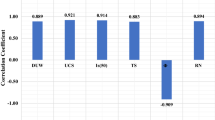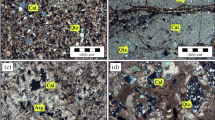Abstract
In the recent years, new techniques such as; Artificial Neural Network (ANN) were employed for developing of the predictive models to estimate the needed parameters. Soft computing techniques are now being used as alternate statistical tool. In this study, ANN models were developed to predict rock properties of sedimentary rock, by using penetration and sound level produced during percussive drilling. The data generated in the laboratory investigation was utilized for the development of ANN models for predicting rock properties like, uniaxial compressive strength, abrasivity, tensile strength, and Schmidt rebound number using air pressure, thrust, bit diameter, penetration rate and sound level. Further, ANN models were also developed for predicting penetration rate and sound level using air pressure, thrust, bit diameter and rock properties as input parameters. The constructed models were checked using various prediction performance indices. ANN models were more acceptable for predicting rock properties.













Similar content being viewed by others
References
T.N. Singh, R. Kanchan, A.K. Verma, S. Singh, An intelligent approach for prediction of triaxial properties using unconfined uniaxial strength. Min. Eng. J. 5, 12–16 (2003)
I. Yilmaz, A.G. Yuksek, An example of artificial neural network application for indirect estimation of rock parameters. Rock Mech. Rock Eng. 41(5), 781–795 (2008)
D. Rumelhart, J. McClelland, Parallel Distributed Processing: Explorations in the Microstructure of Cognition (Bradford Books, MIT Press, Cambridge, 1986)
P.K. Simpson, Artificial Neural System Foundation, Paradigm, Application and Implementation (Pergamon Press, New York, 1990)
L. Zhang, J.H. Jiang, P. Liu, Y.Z. Liang, R.Q. Yu, Multivariate nonlinear modeling of fluorescence data by neural network with hidden mode pruning algorithm. Anal. Chim. Acta 344, 29–39 (1997)
S. Haykin, Neural Networks: A Comprehensive Foundation (MacMillan, New York, 1994)
J.V. Tu, Advantages and disadvantages of using artificial neural networks versus logistic regression in predicting medical outcomes. J. Clin. Epidemiol. 49, 1225–1231 (1996)
M. Majors, J. Stori, C. Dongil, Neural network control of automotive fel-injection systems. Control Syst. Mag. IEEE 14, 31–36 (2002)
C.E. Arzum, K. Yalcin, Evaluating and forecasting banking crises through neural network models: an application for Turkish banking sector. Expert Syst. Appl. 33, 809–815 (2007)
L. Bor-Ren, R.G. Hof, Neural networks and fuzzy logic in power electronics. Control Eng. Pract. 2, 113–121 (2003)
Z. Xiaotian, X. Hong Wang, L. Li, H. Li, Predicting stock index increments by neural networks: the role of trading volume under different horizons. Expert Syst. Appl. 34, 3043–3054 (2008)
G.R. Cheginia, J. Khazaeia, B. Ghobadianb, A.M. Goudarzic, Prediction of process and product parameters in an orange juice spray dryer using artificial neural networks. J. Food Eng. 84, 534–543 (2008)
N.S. Peranbur, A. Preechayasomboon, Development of a neuroinference engine for ADSL modem applications in telecommunications using an ANN with fast computational ability. Neurocomputing 48, 423–441 (2002)
N. Huang, K.K. Tan, T.H. Lee, Adaptive neural network algorithm for control design of rigid-link electrically driven robots. Neurocomputing 71, 885–894 (2008)
P. Venkatesan, S. Anitha, Application of a radial basis function neural network for diagnosis of diabetes mellitus. Curr. Sci. 91(9), 1195–1199 (2006)
E.T. Brown, Rock characterization testing and monitoring. In International Society of Rock Mechanics (ISRM) Suggested Methods (Pergamon, Oxford, 1981)
M. Alvarez Grima, R. Babuska, Fuzzy model for the prediction of unconfined compressive strength of rock samples. Int. J. Rock Mech. Min. Sci. 36, 339–349 (1999)
J. Finol, Y.K. Guo, X.D. Jing, A rule based fuzzy model for the prediction of petrophysical rock parameters. J. Petrol. Sci. Eng. 29, 97–113 (2001)
C. Gokceoglu, A fuzzy triangular chart to predict the uniaxial compressive strength of the Ankara Agglomerates from their petrographic composition. Eng. Geol. 66, 39–51 (2002)
I. Yilmaz, A.G. Yuksek, Prediction of the strength and elasticity modulus of gypsum using multiple regression, ANN, ANFIS models and their comparison. Int. J. Rock Mech. Min. Sci. 46(4), 803–810 (2009)
Author information
Authors and Affiliations
Corresponding author
Rights and permissions
About this article
Cite this article
Kivade, S.B., Murthy, C.S.N. & Vardhan, H. ANN Models for Prediction of Sound and Penetration Rate in Percussive Drilling. J. Inst. Eng. India Ser. D 96, 93–103 (2015). https://doi.org/10.1007/s40033-015-0067-7
Received:
Accepted:
Published:
Issue Date:
DOI: https://doi.org/10.1007/s40033-015-0067-7




